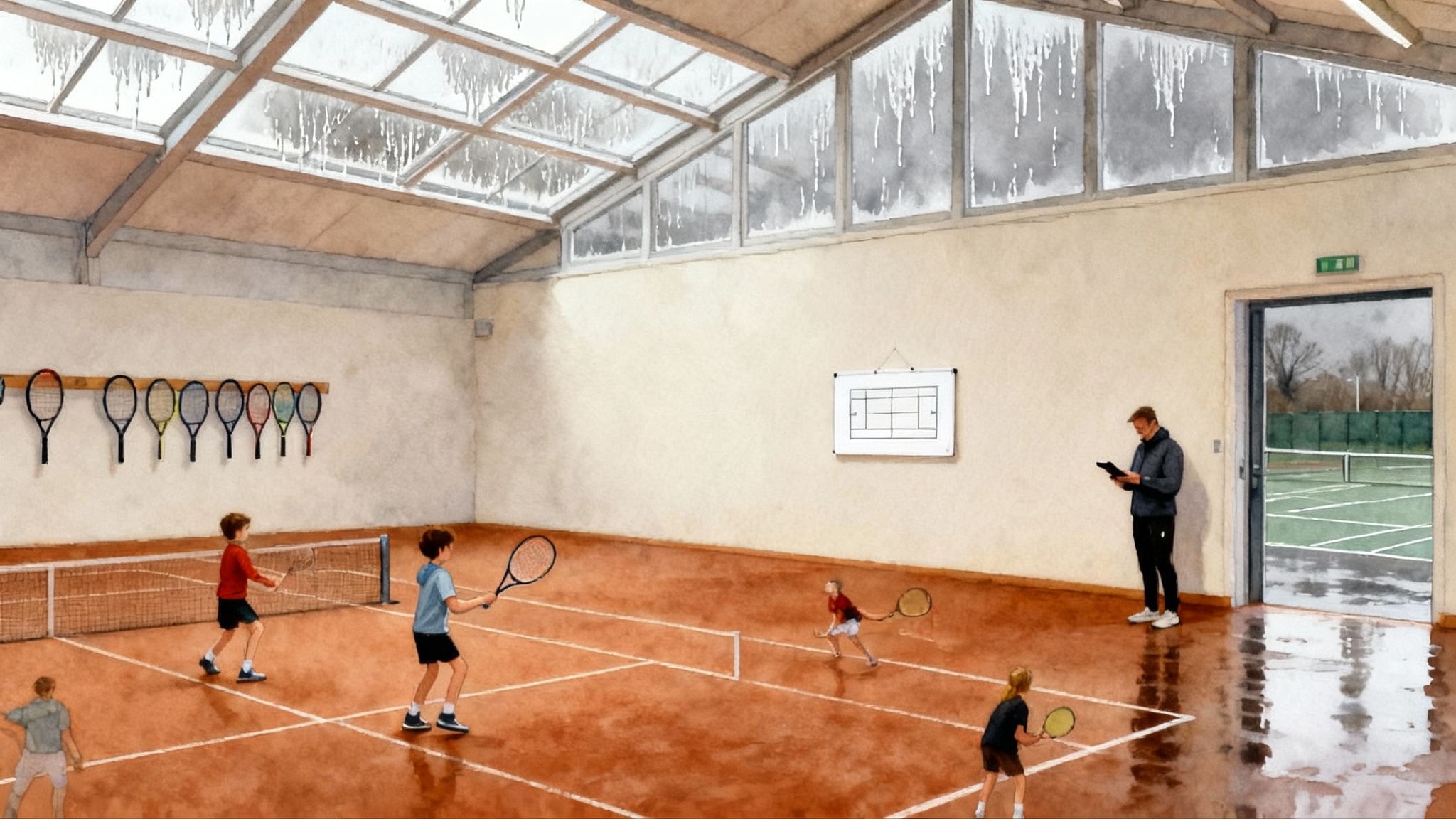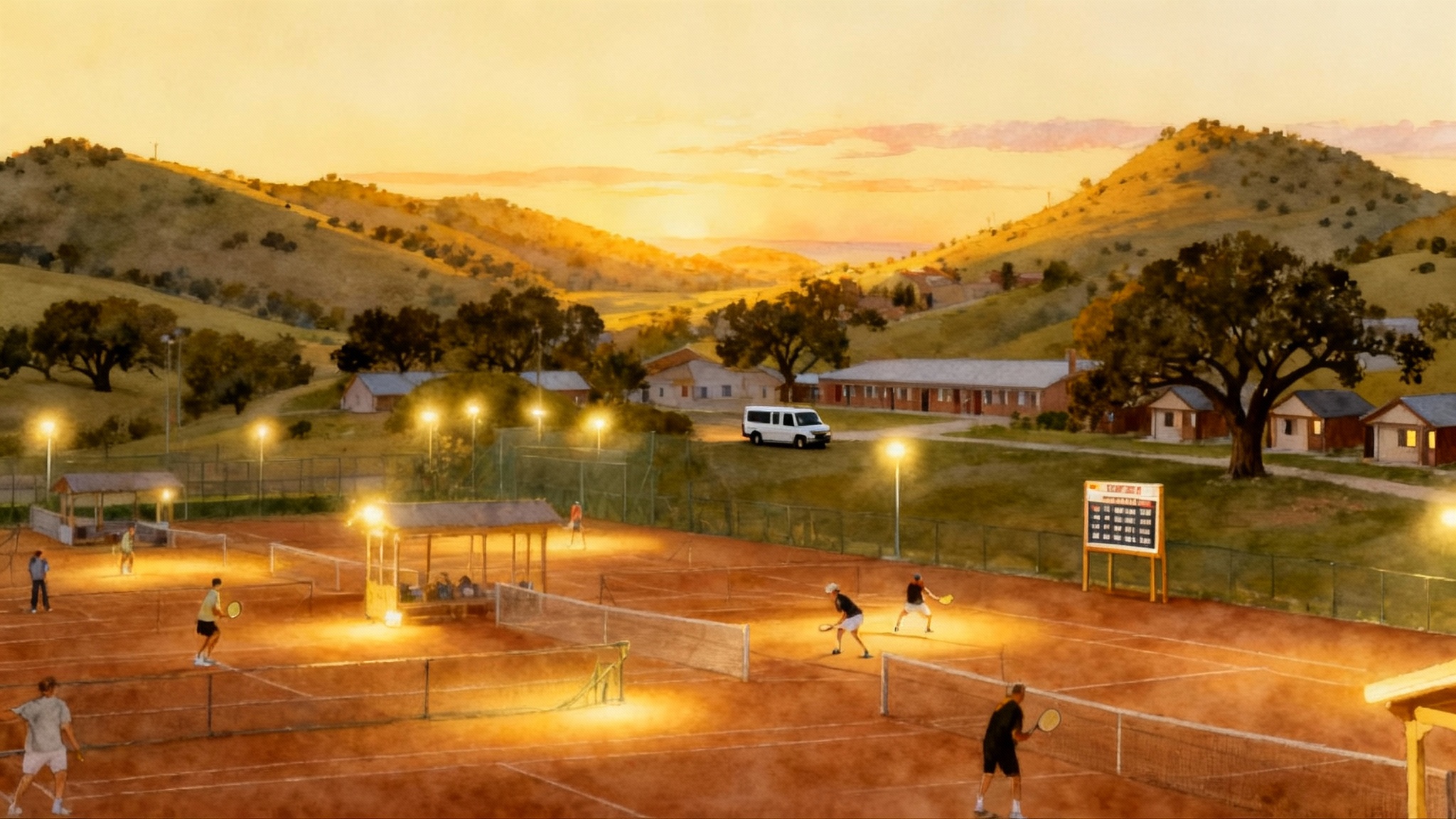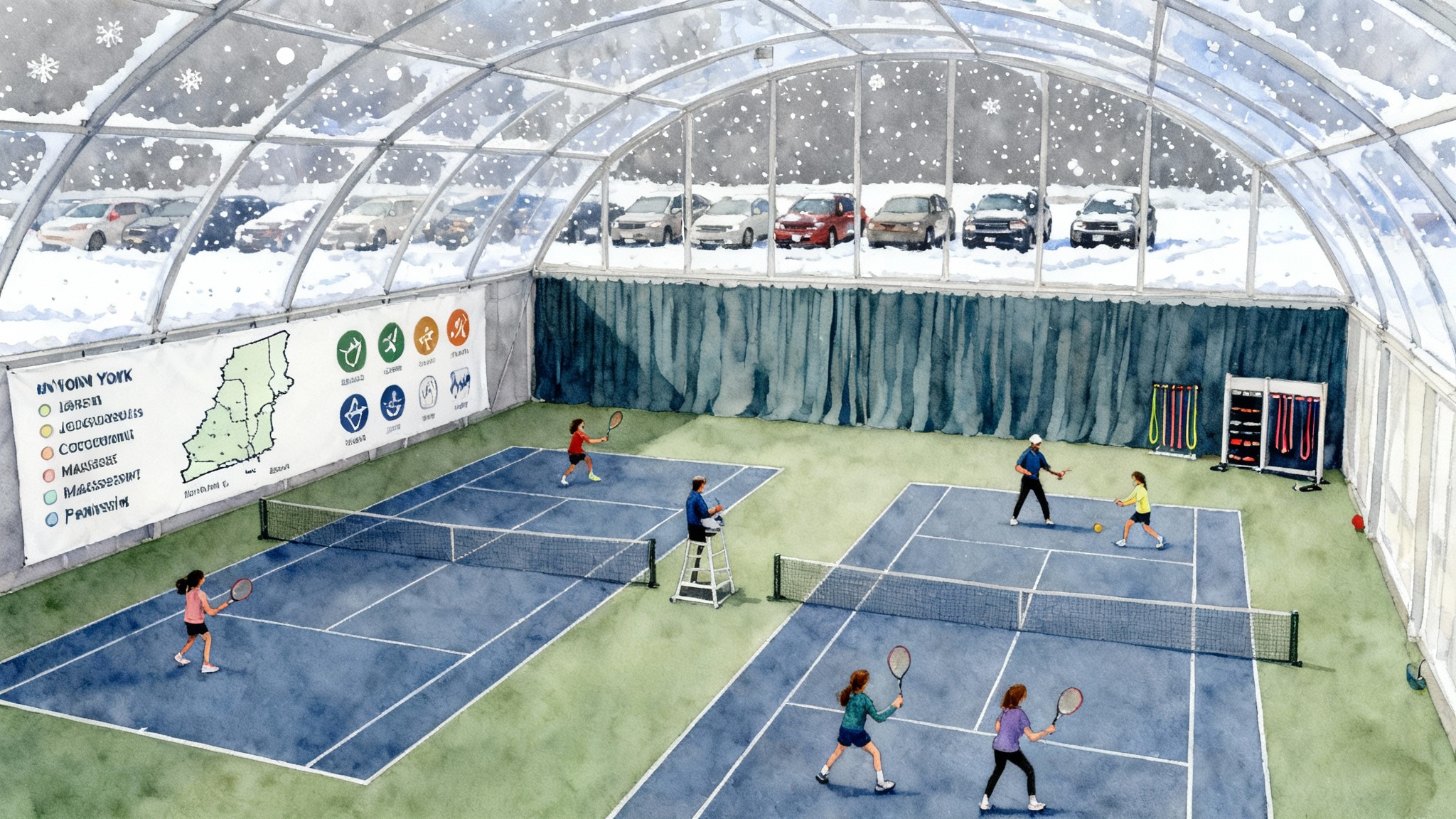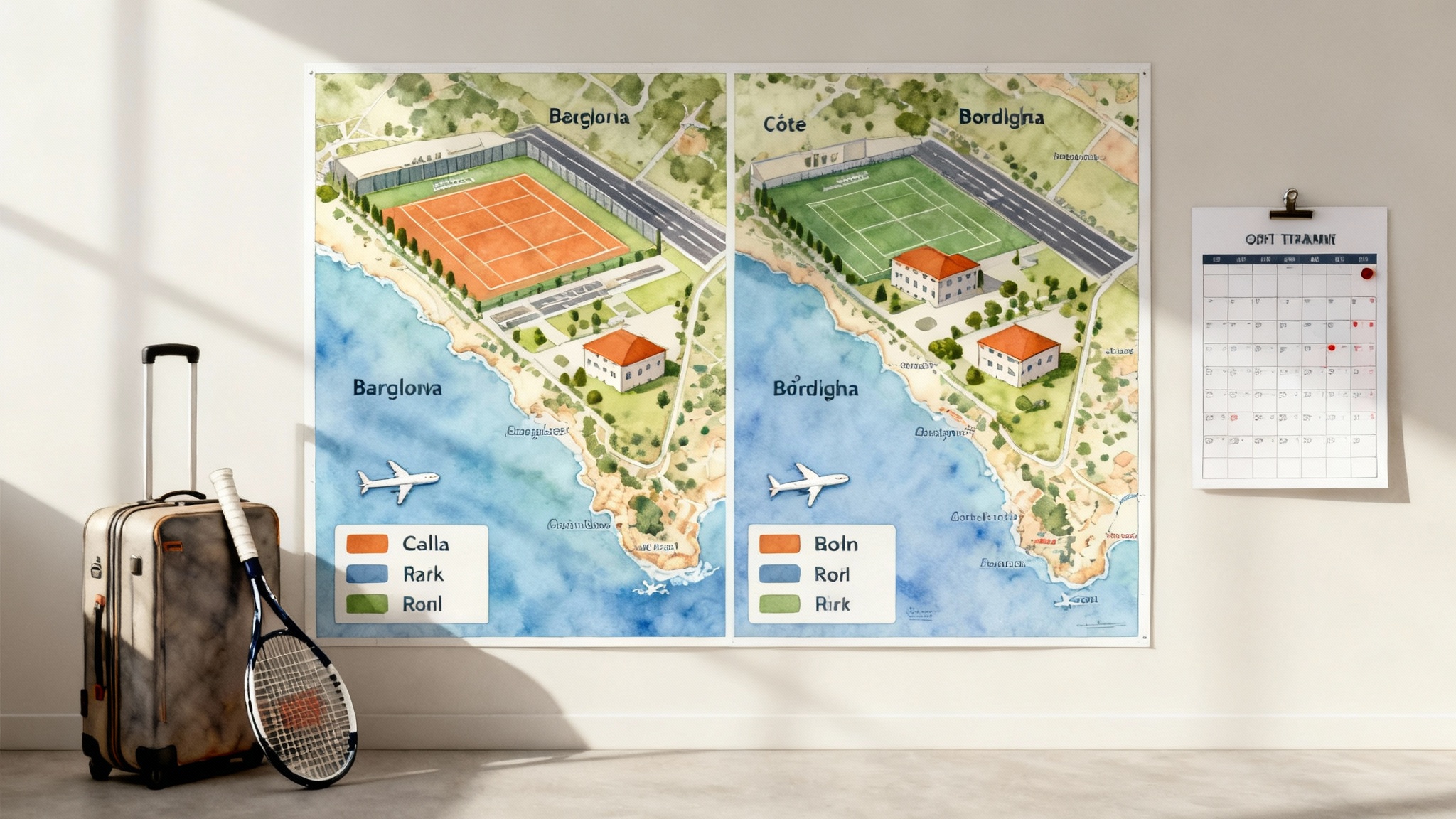Best UK Junior Tennis Academies 2025–2026: A Region Guide
A region by region, data driven guide to the best UK junior tennis academies for the 2025 to 2026 season. Compare indoor coverage, surfaces, coaching ratios, academics, boarding, costs, and tournament travel with clear fit scenarios.

How we compared academies for 2025 to 2026
Choosing a junior tennis academy is part sport decision, part school choice, and part logistics puzzle. For this guide we looked at the criteria parents tell us matter most and built a practical scoring lens you can reuse on any visit or prospectus. If you are also exploring continental options, see our Central Europe academies guide and this Spain vs France vs Italy guide.
What we evaluated:
- Indoor court coverage: proportion of indoor courts to total courts, plus how often indoor time is guaranteed in winter blocks.
- Surface mix: hard, clay, and hybrid surfaces, and how often juniors see each in a typical week.
- Coaching ratios and contact time: average coach to player ratio in technical sessions and tactical squads, plus supervised matchplay hours.
- Academic integration: timetables that flex around training, on site GCSE and A Level options, or formal partner schools.
- Boarding versus day: accommodation options, safeguarding, and travel patterns.
- Progression tracking: how the academy develops and evidences progression in Lawn Tennis Association ratings, World Tennis Number, and Universal Tennis Rating. For families targeting a national pathway, also consider entry routes to the two LTA National Academies.
- Total annual cost: programme fees, strength and conditioning, physio, tournament travel, and tuition or boarding where relevant.
- Tournament travel: frequency of British Tour and Junior International Tennis Federation trips, travel chaperoning, and parent involvement.
Typical bands you can expect in 2025 to 2026 in the United Kingdom:
- Day performance programme: £4,000 to £15,000 for tennis and strength and conditioning, excluding school fees.
- Independent school with integrated tennis: £30,000 to £60,000 including tuition and boarding, with meaningful variance by scholarship, bursary, and sixth form arrangements.
- Travel and events: £2,000 to £10,000 depending on age group, calendar ambition, and distance to key hubs.
- Coaching ratios: technical blocks often 1:2 to 1:4 for performance groups, squads 1:4 to 1:8, with video analysis weekly or fortnightly in stronger programmes.
Use these numbers as a calibration tool. Your short list should still request a written training plan and an itemised fees schedule.
Region by region: credible short lists to start with
Below are starting points by region. They are not exhaustive. Use them to frame visits, compare options, and build a decisive short list.
London and the South East
- Sutton Tennis Academy, Surrey: A long standing performance hub that attracts serious commuters from South London and beyond. Strengths include deep coach benches, year round squads, and strong winter scheduling. Good for day families who want maximal volume without boarding. Look for semiprivate technical time in the plan, and ask how often matchplay is supervised in term time.
- Bromley Tennis Centre, Kent: Known for developing baseline discipline and competitive habits in younger players, with a large community of tournament juniors. Ask about the split of indoor versus outdoor winter hours and how coaching ratios flex during peak exam periods. Reliable option for families in south east London looking to stay day based.
- Reeds School Tennis Academy, Surrey: Independent school pathway with integrated tennis and clear exam support. Boarding is available and sixth form timetables often flex to support higher tournament loads. Good fit for families seeking one home for school and sport. Request clarity on termly tennis fees versus tuition, and how many hours are genuinely ring fenced for individual coaching.
- Gosling Tennis Centre, Hertfordshire: A strong commuter option north of London with meaningful indoor capacity and access to strength and conditioning. Ask how academy players access indoor courts in the 4 to 7 pm window in winter, and what the formal link is to local schools for GCSE and A Level flexibility.
Who this region fits: London commuters who want depth of competition without boarding, and families who value academic optionality with genuine indoor insurance in winter.
South West
- Millfield School, Somerset: One of the most complete sport school environments in the country, with tennis integrated into a broad high performance culture. Works for boarders who want daily access to coaching, strength and conditioning, and therapy. Clarify competition planning, because the school’s breadth can compress indoor access at peaks if not pre booked.
- Team Bath Tennis, University of Bath: A performance environment that suits older juniors who can thrive in a university training culture. Many day students travel in from Bath and Bristol. Confirm coaching ratios in squads, and how academic flexibility is managed for pupils in partner schools.
Who this region fits: Boarders who want a full sport school or sixth form set up, and day families in Somerset or Bristol who want university level strength and conditioning wrapped into tennis.
Midlands and East
- Loughborough performance ecosystem, Leicestershire: The region around the university benefits from coaches, sport science, and competitive squads. For the most elite route, explore the England based LTA National Academy option noted above. Always ask how juniors are integrated with older training groups, and who owns the individual plan.
- Nottingham Tennis Centre, Nottinghamshire: Large venue with a tradition of hosting major events and deep competition lists. Works well for day families in Nottingham and Derby, and for boarders at nearby independent schools with sport friendly timetables. Clarify winter indoor allocations and how tournament blocks are periodised.
- Culford School, Suffolk: A boarding school with a focused tennis programme and strong academic outcomes. Ask for historical data on GCSE and A Level performance for tennis scholars, and what progression looks like in Years 10 to 13.
Who this region fits: Families within striking distance of Nottingham, Leicester, and East Anglia who want strong indoor access and a choice of school models.
North of England
- Bolton Arena and Northern Tennis Centre, Greater Manchester: Together these sites create one of the most competitive weekly matchplay ecosystems in the country. Look for programmes that offer small ratio technical work early mornings, squads after school, and regular British Tour exposure. For boarders, explore local schools with sport timetables or host family arrangements.
- Leeds and Yorkshire hubs: Programmes around Leeds typically blend school partnerships with indoor access and good travel links to the Midlands and North East events. Ask about who travels to tournaments with players and how often parents must drive.
Who this region fits: Northern boarders who want depth of competition within a two hour radius, and day families who want matchplay density without London travel.
Scotland
- University of Stirling ecosystem: Scotland’s high performance nucleus with coaching depth and strong strength and conditioning. For the top track, explore Scotland’s LTA National Academy route, listed with the England base in the official link above. Day families in Central Belt towns can commute, while boarders often pair with partner schools. Clarify exam flexibility, travel to United Kingdom and European events, and the winter indoor schedule.
- Edinburgh independent school options: Several schools offer strong sport timetables with established tennis pathways. Ask to see term time training grids, and seek data on how players’ World Tennis Numbers improved over the prior 12 months.
Who this region fits: Players who want a clear high performance route with university sport science around the corner, and families in Scotland who prefer to stay closer to home.
Wales
- Wrexham Tennis Centre and North Wales network: A well known northern hub with indoor provision and a tradition of hosting national level competition. Works for day families and boarders using host family models. Clarify weekend indoor availability and strength and conditioning access.
- Cardiff performance options: Blends indoor coverage with travel access to South West England events. For sixth formers, ask about timetables that protect morning training and early finishes ahead of squads.
Who this region fits: Families who want to compete across Wales and the West of England without weekly London travel.
A simple scoring rubric you can reuse
Print this, take it to your visits, and score each academy on a 1 to 5 scale per line. If two options tie, go with the one that reduces winter uncertainty and improves your weekly schedule.
- Indoor coverage: 1 is mostly outdoors and weather dependent, 5 is guaranteed indoor hours in winter with priority booking.
- Surface mix: 1 is single surface, 5 is weekly exposure to hard and clay with specific tactical goals attached.
- Coaching ratio: 1 is large squads only, 5 is a weekly block of 1:1 or 1:2 plus small group squads.
- Academic fit: 1 is fixed school day and exam stress, 5 is timetabled flex with planned catch up sessions and teacher buy in.
- Boarding or day fit: 1 is long daily travel with late finishes, 5 is a short commute or on site boarding that protects sleep.
- Progression tracking: 1 is ad hoc results, 5 is written goals with planned steps across LTA ratings, World Tennis Number explained, and Universal Tennis Rating.
- Cost transparency: 1 is vague bundles, 5 is itemised termly invoices and a shared annual calendar with travel cost estimates.
- Tournament travel: 1 is parent led and reactive, 5 is coach led with planned chaperoning and clear post match review.
Add the eight numbers. A 32 or higher usually signals a programme that will protect training quality and your family calendar.
Fit scenarios and model weeks
Below are three realistic scenarios. Treat them as templates to adapt.
London commuter, ages 12 to 14, top county level
- Training model: Three weekday afternoons of squads and matchplay, one early morning technical block, Saturday matchplay. Strength and conditioning twice per week.
- Academic model: Mainstream day school with agreed early finishes two days per week. Homework planned around Mondays and Wednesdays.
- Budget model: £6,000 to £10,000 for coaching and strength and conditioning, £1,500 to £3,000 for travel and strings, rackets, and shoes.
- Why it works: Avoids boarding costs, protects homework time, and taps into London competition density. Key risk is winter traffic and indoor access. Mitigate with one guaranteed early morning indoor slot.
Northern boarder, ages 14 to 16, regional to national transition
- Training model: Daily technical block before school three times per week, squads four afternoons, supervised matchplay twice weekly, strength and conditioning three times. One day reserved for recovery and video analysis.
- Academic model: Boarding school with sport timetable that frees early afternoons, teachers briefed on tournament Fridays. Exam years scheduled with lighter travel blocks from January to May.
- Budget model: £35,000 to £55,000 inclusive of school and boarding, plus £3,000 to £7,000 for travel. Scholarships and bursaries can move this materially, ask early.
- Why it works: Sleep is consistent, indoor time is bankable, and midweek matchplay is protected. Key risk is over scheduling. Mitigate with a monthly recovery weekend and a clear deload week each half term.
Performance track family, age 15 to 17, national to international focus
- Training model: 12 to 16 hours on court per week plus 4 to 6 hours strength and conditioning, with planned International Tennis Federation or British Tour runs. Two coaches coordinate: a technical lead and a travel coach.
- Academic model: Sixth form with flexible blocks or online modules. Exams clustered with a lighter tournament phase.
- Budget model: £10,000 to £20,000 for coaching and strength and conditioning in a day model, or a fully funded slot at an LTA National Academy if selected. Travel can reach £8,000 to £12,000 in a heavy international season.
- Why it works: Clear periodisation, travel support, and integrated performance services. Key risk is academic drift. Mitigate with a named academic mentor and weekly study hours on the calendar.
What to ask on every visit
Use concise, practical questions. You want evidence, not slogans.
- Indoor certainty: Which hours are guaranteed indoors between November and March, and how many are in prime time.
- Ratio reality: What was last term’s average ratio in performance squads, and how often did cancellations or coach reassignments change that ratio.
- Surface plan: How many weeks of clay exposure will my child get, and what are the tactical goals for those blocks.
- Individual plan: Who writes and owns the plan, how often is it updated, and what data is tracked monthly.
- Academic proof: Show me last year’s GCSE and A Level outcomes for tennis pupils, and how exam blocks altered training.
- Progression data: Provide last year’s average improvements in World Tennis Number and Universal Tennis Rating for players at my child’s current level.
- Travel calendar: Which events are coach chaperoned, how video review works after losses, and how costs are split.
- Duty of care: Curfew rules, attendance tracking, physio triage, and how injuries trigger plan changes.
Key trade offs to decide up front
- Boarding or commute: Boarding buys sleep and structure. Commuting buys family time and control. If your commute one way is over 60 minutes in winter traffic, boarding often nets more quality hours.
- One home or two specialists: A full service academy can be convenient, but some families do technical work with a small ratio coach and use a separate club for squads and matchplay. The latter can be cheaper and more bespoke if you are organised.
- Exam years: Protect grades by shifting volume earlier in the season, then hold quality rather than quantity from January to May. Ask for a written exam term training plan before you enrol.
Building a short list, region by region
Here is a simple process that turns research into a decision in two weekends.
- Pick your region and shortlist three to five programmes using this guide.
- Email each with your child’s age, current results, and goals. Ask for a trial week with ratios and indoor time stated in writing.
- Visit on a normal weekday in winter hours. Watch one technical session and one squad, and ask to see a match debrief.
- Score the academy using the eight line rubric. Photograph the whiteboard or session plan if allowed.
- Request an itemised annual cost projection with a tournament calendar. Ask where the hidden costs sit.
- Sleep on it and choose the option that solves winter, secures ratios, and protects school.
Frequently asked specifics
- Which rating matters most: Use World Tennis Number for domestic benchmarking and Universal Tennis Rating for international seeding and event entry logic. Consistent weekly matchplay against slightly stronger players tends to move both numbers. Ask the academy to show a plausible six month progression with named events. If college tennis is a goal, read our 2025 college recruiting roadmap.
- Strength and conditioning: For ages 12 to 14, two 45 minute sessions that emphasise movement quality and injury prevention usually outperform a third long gym session. For ages 15 to 17, add power and robustness, but protect technical time.
- Video and analytics: One purposeful video review every two weeks can change habits faster than extra hitting. Ask who runs the session and how clips are shared.
- Strings and equipment: Budget for stringing every 10 to 15 hours of hard hitting or after each tournament weekend. Keep notes on tension and pair changes with video to see patterns.
The bottom line
Pick the academy that reduces uncertainty in winter, proves its coaching ratios in writing, and integrates school rather than hoping it will somehow fit around tennis. If you lock those three variables, progression in ratings and results will follow, and your family life will feel sustainable across the 2025 to 2026 season.



